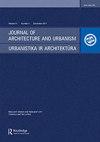TEACHING WHOLENESS IN ARCHITECTURE EDUCATION: ADVANCING CHRISTOPHER ALEXANDER’S TEACHING LEGACY THROUGH THE BUILDING BEAUTY PROGRAM
IF 0.8
0 ARCHITECTURE
引用次数: 0
Abstract
Architect, builder, and professor Christopher Alexander focused his life’s work on trying to understand what makes the physical environment beautiful, and how beautiful environments can be created today. Through careful research, innovative teaching, and unorthodox professional practice, Alexander formulated a unified vision of the physical environment based on a theory of “wholeness.” He observed that achieving beauty and wholeness in the built environment – as well as teaching it – requires the integration of processes and considerations that are usually kept separate: integrating form and function, integrating teaching and practice, integrating design and construction, integrating projects of various scales, and integrating all of these within the ongoing search for how beauty and wholeness might be reached, taught, and proliferated. Alexander explored and developed ways of implementing these observations throughout his decades of teaching at the University of California at Berkeley, culminating in the Building Process Area of Emphasis, which he founded with his colleagues in 1990. His former students from this period, together with new partners, established “Building Beauty” in 2017, a post-graduate program in architecture that continues to teach and expand upon Alexander’s theories and methods of generating beauty and wholeness in the physical environment.建筑教育中的整体性教学:通过建筑美学项目推进克里斯托弗·亚历山大的教学遗产
建筑师、建造者、教授克里斯托弗·亚历山大毕生致力于理解是什么让自然环境变得美丽,以及今天如何创造美丽的环境。通过仔细的研究、创新的教学和非正统的专业实践,亚历山大在“整体性”理论的基础上制定了一个统一的物理环境愿景。他观察到,在建筑环境中实现美和整体性——以及教授美和整体性——需要将通常保持分离的过程和考虑因素整合起来:整合形式和功能,整合教学和实践,整合设计和施工,整合各种规模的项目,并将所有这些整合在不断探索如何达到、教授和扩散美和整体性的过程中。亚历山大在加州大学伯克利分校数十年的教学中探索并发展了实现这些观察的方法,最终在1990年与他的同事一起创立了Building Process Area of Emphasis。他在这一时期的学生与新的合作伙伴一起,在2017年建立了“建筑之美”,这是一个建筑研究生课程,继续教授和扩展亚历山大在物理环境中产生美和整体性的理论和方法。
本文章由计算机程序翻译,如有差异,请以英文原文为准。
求助全文
约1分钟内获得全文
求助全文
来源期刊

Journal of Architecture and Urbanism
ARCHITECTURE-
CiteScore
1.30
自引率
14.30%
发文量
12
审稿时长
15 weeks
期刊介绍:
The Journal of Architecture and Urbanism publishes original research on all aspects of urban architecture.
 求助内容:
求助内容: 应助结果提醒方式:
应助结果提醒方式:


